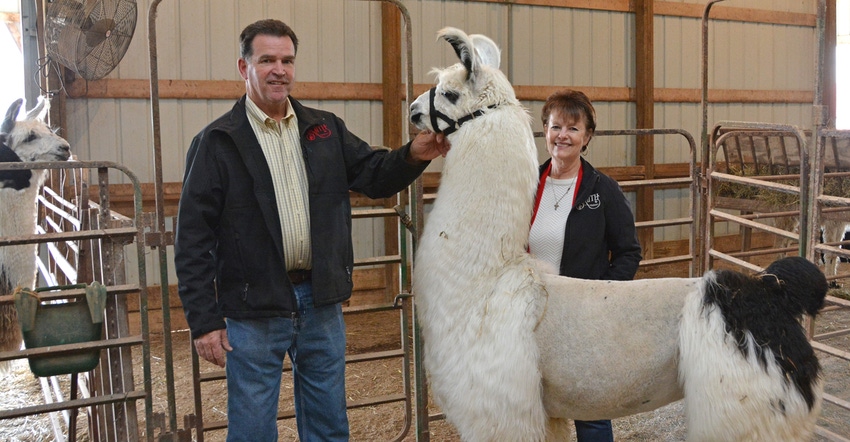May 23, 2022

On Mark and Susan Smith’s llama farm in Montgomery County, Ind., you can find upward of 70 llamas in the pasture. While the Smiths are lifelong grain and livestock farmers and longtime Indiana Farm Bureau members, the llama portion of their farm has grown significantly since they started the business in 1994.
Although both Mark and Susan grew up showing livestock and sheep, they didn’t consider raising llamas until they bought a couple to guard their sheep. Llamas are a good alternative to dogs because they have the same friendly demeanor, but they live longer, with an average lifespan of 20 years.
Indigenous to South America, llamas can also be used for packing and as a fiber source. However, they have gained popularity in the U.S. as mainly show animals and pasture pets.
“People think they spit, and they don’t,” Susan explains. “It’s a common misconception. They really have a good disposition — very versatile and easy to work with.”
More than a hobby
Over the past 28 years, the Smiths have bred, owned or sold over 50 national champion or reserve champion llamas — more than anyone in the country. While they started selling llamas to the 4-H market, most of their business now comes from sales of show-quality llamas to customers across the country who want to show the animals themselves.
“I love the showmanship of it,” Mark says. “I don’t golf, fish or have a boat. This is my hobby, but it’s also a full-time production and business. It feeds the competitiveness that I grew up with from livestock shows.
“It’s also nice to see our customers do well and succeed with the genetics and the llamas we breed.”
The Smiths have competed in llama shows all over the U.S., as well as internationally, traveling to shows in Canada, New Zealand, France and Switzerland. Mark serves as a judge, too.
The Midwest has become somewhat of a hub for llama competitions and auctions. In fact, one of the largest shows in the country takes place in Cloverdale, Ind., titled March Llama Madness. This past year, the Smiths took home accolades including best of show male and reserve champions for heavy wool female and silky wool female.
Bonding with people, too
The Smiths explain that llama competitions create friendships and bonds with other owners who share the same love and passion for the animal.
“They are fairly easy to raise, and you don’t need a traditional ag background to do it, so you meet all types of people — from farmers, teachers and people with white-collar jobs to millionaires,” Mark says. “Showing llamas brings people together. It’s really unique.”
The Smiths aren’t planning to slow down their llama operation anytime soon. They enjoy this business on top of their traditional corn and soybean farm. It’s also a benefit to diversify.
“We aren’t putting all of our eggs in one farming basket,” Susan says.
Mark notes that when grain inputs have been down, the llama business has usually been up.
“Production ag doesn’t impact llama prices, which lessens the burden a bit,” he notes. “That’s the beauty of diversity.”
Baker is the public relations manager-brand for Indiana Farm Bureau Inc.
You May Also Like




